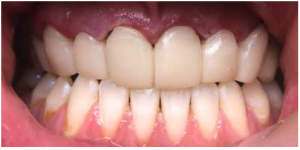Kilby Family and Cosmetic Dentistry can provide a wide range of dental services. We can typically provide every type of dental service without having to refer you to other specialties. This flexibility saves you time and keeps your total dental care within one practice. Our emphasis is on total preventive care for our patients. Total care begins with regular hygiene visits, regular check-ups and continued home oral health routines.
Our practice also provides the highest-quality services for restoring mouths that have been damaged by dental disease and injury and common problems that require cosmetic dentistry. At Kilby Family and Cosmetic Dentistry, our entire team is dedicated to providing you with the personalized, gentle care that you deserve. We know how much a healthy mouth contributes to a happy life, and we are committed to maintaining your beautiful smile for a lifetime.
Patient Testimonials
Dr. Kilby has a friendly staff, and he does an excellent job.
Cason S.
Got two wisdom teeth taken out and a few fillings. No pain what so ever!
Ronnie N.
Very nice and thorough. He answered every question I had.
Michele J.
Dr Kilby is a great Dentist with great chair side manners.
Vicky L.
Most gentle, understanding, and professional Dentist I have ever been to.
Sharon E.
 A composite (tooth colored) filling is used to repair a tooth that is affected by decay, cracks, fractures, etc. The decayed or affected portion of the tooth will be removed and then filled with a composite filling. There are many types of filling materials available, each with their own advantages and disadvantages. You and Dr. Kilby can discuss the best options for restoring your teeth. Composite fillings are the most widely used today. Because composite fillings are tooth colored, they can be closely matched to the color of existing teeth, and are more aesthetically suited for use in front teeth or the more visible areas of the teeth. As with most dental restorations, composite fillings are not permanent and may someday have to be replaced. They are very durable, and will last many years, giving you a long lasting, beautiful smile.
A composite (tooth colored) filling is used to repair a tooth that is affected by decay, cracks, fractures, etc. The decayed or affected portion of the tooth will be removed and then filled with a composite filling. There are many types of filling materials available, each with their own advantages and disadvantages. You and Dr. Kilby can discuss the best options for restoring your teeth. Composite fillings are the most widely used today. Because composite fillings are tooth colored, they can be closely matched to the color of existing teeth, and are more aesthetically suited for use in front teeth or the more visible areas of the teeth. As with most dental restorations, composite fillings are not permanent and may someday have to be replaced. They are very durable, and will last many years, giving you a long lasting, beautiful smile.
How are composite fillings placed?
Composite fillings are usually placed in one appointment. While the tooth is numb, Dr. Kilby will remove decay as necessary. The space will then be thoroughly cleaned and carefully prepared before the new filling is placed. If the decay was near the nerve of the tooth, a special medication will be applied for added protection. The composite filling will then be precisely placed, shaped, and polished, restoring your tooth to its original shape and function.
It is normal to experience sensitivity to hot and cold when composite fillings are first placed, however this will subside shortly after your tooth acclimates to the new filling. You will be given care instructions at the conclusion of your treatment. Good oral hygiene practices, eating habits, and regular dental visits will aid in the life of your new fillings.
 When a tooth is over 50% filling it has been weakened and is at risk for fracture. In these situations it is recommended to have the tooth covered by a Crown (cap). A crown can be made of many different materials depending upon the desired outcome to help prevent a fracture and eventual loss of the tooth. A crown can make your tooth stronger as well as make it look better. It can protect a weak tooth from breaking or restore one that is already broken.
When a tooth is over 50% filling it has been weakened and is at risk for fracture. In these situations it is recommended to have the tooth covered by a Crown (cap). A crown can be made of many different materials depending upon the desired outcome to help prevent a fracture and eventual loss of the tooth. A crown can make your tooth stronger as well as make it look better. It can protect a weak tooth from breaking or restore one that is already broken.
What does getting a crown involve?
A crown procedure usually requires two appointments. Your first appointment will include taking several highly accurate molds (or impressions) that will be used to create your custom crown. A mold will also be used to create a temporary crown which will stay on your tooth for approximately two weeks until your new crown is fabricated by a dental laboratory.
While the tooth is numb, the Dr. Kilby will prepare the tooth by removing any decay and shaping the surface to properly fit the crown. Once these details are accomplished, your temporary crown will be placed with temporary cement and your bite will be checked to ensure you are biting properly. At your second appointment your temporary crown will be removed, the tooth will be cleaned, and your new crown will be carefully placed to ensure the spacing and bite are accurate. You will be given care instructions and encouraged to have regular dental visits to check your new crown.

Full Mouth Reconstruction with Crowns, Bridges after Periodontal Surgery
A bridge replaces missing teeth with artificial teeth which alleviates the stresses on the teeth on either side of the space. Unlike a partial denture which is removable for hygiene purposes a bridge is known as a fixed partial denture because it is cemented to place. Your home care is critical to the long term success of a bridge as it cannot be removed for cleaning purposes and the teeth are attached so normal flossing is not possible. If proper hygiene practices are followed patients have had many years of success with bridges as a replacement for missing teeth.
What does getting a fixed bridge involve?
Getting a bridge usually requires two or more visits. While the teeth are numb, the two anchoring teeth are prepared by removing a portion of enamel to allow for a crown. Next, a highly accurate impression (mold) is made which will be sent to a dental laboratory where the bridge will be fabricated. In addition, a temporary bridge will be made and worn for several weeks until your next appointment.
At the second visit, you permanent bridge will be carefully checked, adjusted, and cemented to achieve a proper fit. Occasionally, Dr. Kilby may only temporarily cement the bridge, allowing your teeth and tissue time to get used to the new bridge. The new bridge will be permanently cemented at a later time. You will receive care instructions at the conclusion of your treatment. Proper brushing, flossing and regular dental visits will aid in the life of your new permanent bridge.
 If a tooth gets damaged by a deep cavity, trauma, or a fracture it may need a root canal. Root canal therapy is a common procedure to remove the nerve of the tooth in order to prevent the loss of the tooth and to keep your mouth healthy. Root canal therapy consists of one or two appointments to clean out the inside of the tooth where the infected nerve lived and to seal it with a material to prevent bacteria from re-infecting it. Following a root canal a tooth requires a crown to prevent future fracture and to seal off the root canal system. Delaying treatment for a toothache increases the risk of not being able to save the tooth.
If a tooth gets damaged by a deep cavity, trauma, or a fracture it may need a root canal. Root canal therapy is a common procedure to remove the nerve of the tooth in order to prevent the loss of the tooth and to keep your mouth healthy. Root canal therapy consists of one or two appointments to clean out the inside of the tooth where the infected nerve lived and to seal it with a material to prevent bacteria from re-infecting it. Following a root canal a tooth requires a crown to prevent future fracture and to seal off the root canal system. Delaying treatment for a toothache increases the risk of not being able to save the tooth.
What does root canal therapy involve?
A root canal procedure requires one or more appointments and can be performed by Dr. Kilby or an endodontist (a root canal specialist). While the tooth is numb, a rubber dam (a sheet of rubber) will be placed around the tooth to keep it dry and free of saliva. An access opening is made on top of the tooth and a series of root canal files are placed into the opening, one at a time, removing the pulp, nerve tissue, and bacteria. If tooth decay is present, it will also be removed with special dental instruments. Once the tooth is thoroughly cleaned, it will be sealed with either a permanent filling or, if additional appointments are needed, a temporary filling will be placed.
At the next appointment, usually a week later, the roots and the inside cavity of the tooth will be filled and sealed with special dental materials. A filling will be placed to cover the opening on top of the tooth. In addition, some teeth that have root canal treatment should have a crown (cap) placed. This will protect the tooth and prevent it from breaking, and restore it to its full function.
After treatment, your tooth may still be sensitive, but this will subside as the inflammation diminishes and the tooth has healed. You will be given care instructions after each appointment. Good oral hygiene practices and regular dental visits will aid in the life of your root canal treatment.
 In some cases, root canal therapy doesn’t completely heal an infected tooth, and root canal retreatment becomes necessary. Some of the reasons a root canal fails are your tooth has curved, narrow, or blocked canals. Your tooth may have extra canals that were not found the first time. Tooth decay or a fracture can expose the roots to bacteria which causes a new infection. Root canal retreatment removes infection, relieves discomfort, and saves your tooth.
In some cases, root canal therapy doesn’t completely heal an infected tooth, and root canal retreatment becomes necessary. Some of the reasons a root canal fails are your tooth has curved, narrow, or blocked canals. Your tooth may have extra canals that were not found the first time. Tooth decay or a fracture can expose the roots to bacteria which causes a new infection. Root canal retreatment removes infection, relieves discomfort, and saves your tooth.
What does root canal retreatment involve?
On the day of the retreatment procedure a local anesthetic will be administered, unless another type of anesthetic has been selected. The affected tooth is isolated with a rubber dam. The dam protects the tooth during treatment from bacteria and saliva. The amount Dr. Kilby can do within a single appointment will much depend on the amount of inflammation present, and the complexity of the treatment.
The first step in a root canal retreatment is to gain access to the inner tooth. If a crown and post have been placed, these will be removed. Next, filling material and obstructions that block the root canals will be removed. This removal is conducted using an ultrasonic handpiece. The advantage of using this tool is that any unwanted material is vibrated loose. Tiny instruments will then be used to clean and reshape the root canals. X-rays may be taken to ensure that the roots are thoroughly clean. If this part of the treatment proves to be complex, medicated packing material will be applied, and the rest of the cleansing procedure will be done at the next visit.

